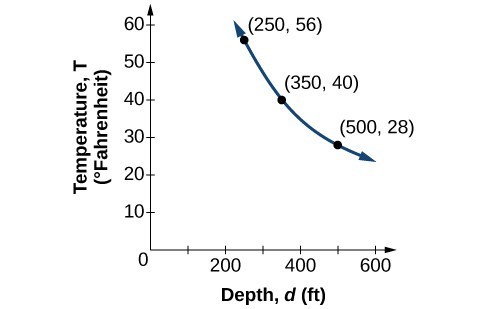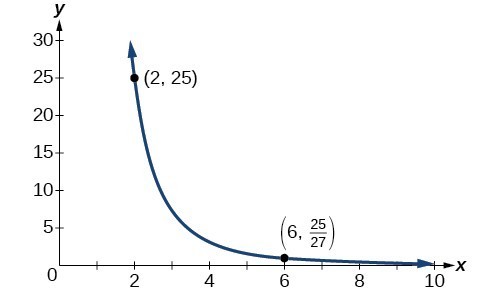Inverse and Joint Variation
Learning Objectives
- Solve an Inverse variation problem
- Write a formula for an inversely proportional relationship
| d, depth | [latex]T=\frac{\text{14,000}}{d}[/latex] | Interpretation |
|---|---|---|
| 500 ft | [latex]\frac{14,000}{500}=28[/latex] | At a depth of 500 ft, the water temperature is 28° F. |
| 350 ft | [latex]\frac{14,000}{350}=40[/latex] | At a depth of 350 ft, the water temperature is 40° F. |
| 250 ft | [latex]\frac{14,000}{250}=56[/latex] | At a depth of 250 ft, the water temperature is 56° F. |

A General Note: Inverse Variation
If x and y are related by an equation of the form [latex-display]y=\frac{k}{{x}^{n}}[/latex-display] where k is a nonzero constant, then we say that y varies inversely with the nth power of x. In inversely proportional relationships, or inverse variations, there is a constant multiple [latex]k={x}^{n}y[/latex].Example: Writing a Formula for an Inversely Proportional Relationship
A tourist plans to drive 100 miles. Find a formula for the time the trip will take as a function of the speed the tourist drives.Answer: Recall that multiplying speed by time gives distance. If we let t represent the drive time in hours, and v represent the velocity (speed or rate) at which the tourist drives, then vt = distance. Because the distance is fixed at 100 miles, vt = 100. Solving this relationship for the time gives us our function.
[latex]\begin{array}{c}t\left(v\right)=\frac{100}{v}\hfill \\ \text{ }=100{v}^{-1}\hfill \end{array}[/latex]
We can see that the constant of variation is 100 and, although we can write the relationship using the negative exponent, it is more common to see it written as a fraction.How To: Given a description of an indirect variation problem, solve for an unknown.
- Identify the input, x, and the output, y.
- Determine the constant of variation. You may need to multiply y by the specified power of x to determine the constant of variation.
- Use the constant of variation to write an equation for the relationship.
- Substitute known values into the equation to find the unknown.
Example: Solving an Inverse Variation Problem
A quantity y varies inversely with the cube of x. If y = 25 when x = 2, find y when x is 6.Answer: The general formula for inverse variation with a cube is [latex]y=\frac{k}{{x}^{3}}[/latex]. The constant can be found by multiplying y by the cube of x.
[latex]\begin{array}{c}k={x}^{3}y\hfill \\ \text{ }={2}^{3}\cdot 25\hfill \\ \text{ }=200\hfill \end{array}[/latex]
Now we use the constant to write an equation that represents this relationship.[latex]\begin{array}{c}y=\frac{k}{{x}^{3}},k=200\hfill \\ y=\frac{200}{{x}^{3}}\hfill \end{array}[/latex]
Substitute x = 6 and solve for y.[latex]\begin{array}{c}y=\frac{200}{{6}^{3}}\hfill \\ \text{ }=\frac{25}{27}\hfill \end{array}[/latex]
Analysis of the Solution
The graph of this equation is a rational function.
Try It
A quantity y varies inversely with the square of x. If y = 8 when x = 3, find y when x is 4.Answer: [latex]\frac{9}{2}[/latex]
Joint Variation
Many situations are more complicated than a basic direct variation or inverse variation model. One variable often depends on multiple other variables. When a variable is dependent on the product or quotient of two or more variables, this is called joint variation. For example, the cost of busing students for each school trip varies with the number of students attending and the distance from the school. The variable c, cost, varies jointly with the number of students, n, and the distance, d.A General Note: Joint Variation
Joint variation occurs when a variable varies directly or inversely with multiple variables. For instance, if x varies directly with both y and z, we have x = kyz. If x varies directly with y and inversely with z, we have [latex]x=\frac{ky}{z}[/latex]. Notice that we only use one constant in a joint variation equation.Example: Solving Problems Involving Joint Variation
A quantity x varies directly with the square of y and inversely with the cube root of z. If x = 6 when y = 2 and z = 8, find x when y = 1 and z = 27.Answer: Begin by writing an equation to show the relationship between the variables.
[latex]x=\frac{k{y}^{2}}{\sqrt[3]{z}}[/latex]
Substitute x = 6, y = 2, and z = 8 to find the value of the constant k.[latex]\begin{array}{c}6=\frac{k{2}^{2}}{\sqrt[3]{8}}\hfill \\ 6=\frac{4k}{2}\hfill \\ 3=k\hfill \end{array}[/latex]
Now we can substitute the value of the constant into the equation for the relationship.[latex]x=\frac{3{y}^{2}}{\sqrt[3]{z}}[/latex]
To find x when y = 1 and z = 27, we will substitute values for y and z into our equation.[latex]\begin{array}{c}x=\frac{3{\left(1\right)}^{2}}{\sqrt[3]{27}}\hfill \\ \text{ }=1\hfill \end{array}[/latex]
Try It
x varies directly with the square of y and inversely with z. If x = 40 when y = 4 and z = 2, find x when y = 10 and z = 25.Answer: [latex]x=20[/latex]
Licenses & Attributions
CC licensed content, Original
- Revision and Adaptation. Provided by: Lumen Learning License: CC BY: Attribution.
CC licensed content, Shared previously
- Question ID 91393,91394. Authored by: Jenck,Michael (for Lumen Learning). License: CC BY: Attribution. License terms: IMathAS Community License CC-BY + GPL.
- College Algebra. Provided by: OpenStax Authored by: Abramson, Jay et al.. Located at: https://openstax.org/books/college-algebra/pages/1-introduction-to-prerequisites. License: CC BY: Attribution. License terms: Download for free at http://cnx.org/contents/[email protected].
- Inverse Variation. Authored by: James Sousa (Mathispower4u.com) for Lumen Learning. License: CC BY: Attribution.
- Joint Variation: Determine the Variation Constant (Volume of a Cone). Provided by: Joint Variation: Determine the Variation Constant (Volume of a Cone) Authored by: James Sousa (Mathispower4u.com) for Lumen Learning. License: CC BY: Attribution.
